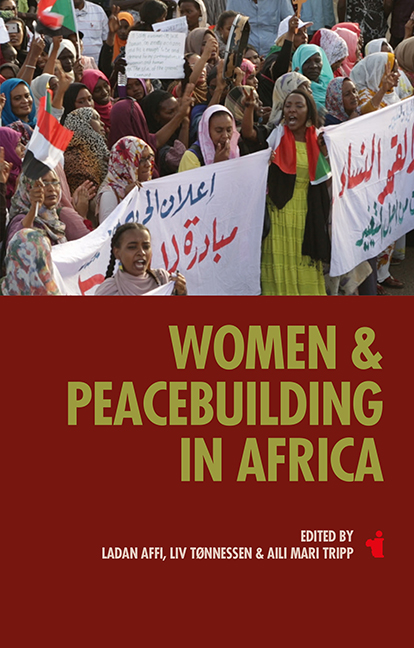Book contents
- Frontmatter
- Contents
- List of Illustrations
- Notes on Contributors
- Acknowledgement
- Abbreviations
- Maps
- 1 Introduction: The Gendering of Peacebuilding in Africa
- 2 Women Activists’ Informal Peacebuilding Strategies in South Sudan
- 3 ‘Ba Sa Jin Mu’ (They Don’t Listen to Us): Women and Peacebuilding in North-Eastern Nigeria
- 4 No Going Back: Somali Women’s Fight for Political Inclusion
- 5 Sudanese Women’s Demands for Freedom, Peace, and Justice in the 2019 Revolution
- 6 The Fight for Democracy and Women’s Rights in Algeria: A Long Legacy of Struggle
- 7 Conclusions: Women’s Peace Activism in Africa
- Bibliography
- Index
1 - Introduction: The Gendering of Peacebuilding in Africa
Published online by Cambridge University Press: 26 May 2022
- Frontmatter
- Contents
- List of Illustrations
- Notes on Contributors
- Acknowledgement
- Abbreviations
- Maps
- 1 Introduction: The Gendering of Peacebuilding in Africa
- 2 Women Activists’ Informal Peacebuilding Strategies in South Sudan
- 3 ‘Ba Sa Jin Mu’ (They Don’t Listen to Us): Women and Peacebuilding in North-Eastern Nigeria
- 4 No Going Back: Somali Women’s Fight for Political Inclusion
- 5 Sudanese Women’s Demands for Freedom, Peace, and Justice in the 2019 Revolution
- 6 The Fight for Democracy and Women’s Rights in Algeria: A Long Legacy of Struggle
- 7 Conclusions: Women’s Peace Activism in Africa
- Bibliography
- Index
Summary
In October 2000, Namibia, which held the presidency of the United Nations Security Council at the time, brought a seminal resolution to the floor of the Council. After considerable pushback from Security Council members, the resolution, UNSCR 1325, was finally passed. It was to redefine women's role in peacebuilding (Ileke and Imene-Chanduru 2020). It recognised the importance of women's participation and the inclusion of gender perspectives in peace negotiations, humanitarian activities, peacekeeping operations, and postconflict peacebuilding and governance. Twenty years after the passage of UNSCR 1325, there is widespread recognition that although some gains have been made, there is still a long way to go to fully implement this resolution and to do so in a way that more fully accounts for the many ways both men and women are treated in peacebuilding. This has particular bearing on Africa because some of the deadliest conflicts can be found on the continent, in the areas affected by Boko Haram, the Sahel, South Sudan, and Somalia.
Peacebuilding is commonly understood to involve measures aimed at reducing the risk of return to conflict by strengthening national capacity for conflict management and laying the foundation for durable peace and development. Traditionally, peacebuilding has included support for conflict prevention through the protection of civilians; peacemaking through the use of diplomacy, negotiations, and community strategies; peacekeeping through external interventions supported by the UN or regional peacekeepers; and disarmament, demobilisation, and reintegration (DDR) programmes; along with security sector reform. And finally, peacebuilding has included transitional justice mechanisms that focus on inclusive dialogue, reconciliation and truth processes, and strengthening the rule of law.
Many of these liberal peacebuilding strategies have been seen as problematic because they have focused almost exclusively on formal statebuilding and technocratic solutions, the professionalisation of personnel, standardisation of operating procedures, and honing best practices focused on the state. These types of strategies have been carried out to the exclusion of grassroots activities (Mac Ginty and Firchow 2016). Critics of peacebuilding and statebuilding have argued that these strategies, as they have been implemented, have not always delivered results and that they are an extension of Western ideology, promoting a free market economy and creating countries dependent on Western aid (Bindi and Tufekci 2018).
- Type
- Chapter
- Information
- Women and Peacebuilding in Africa , pp. 1 - 28Publisher: Boydell & BrewerPrint publication year: 2021

